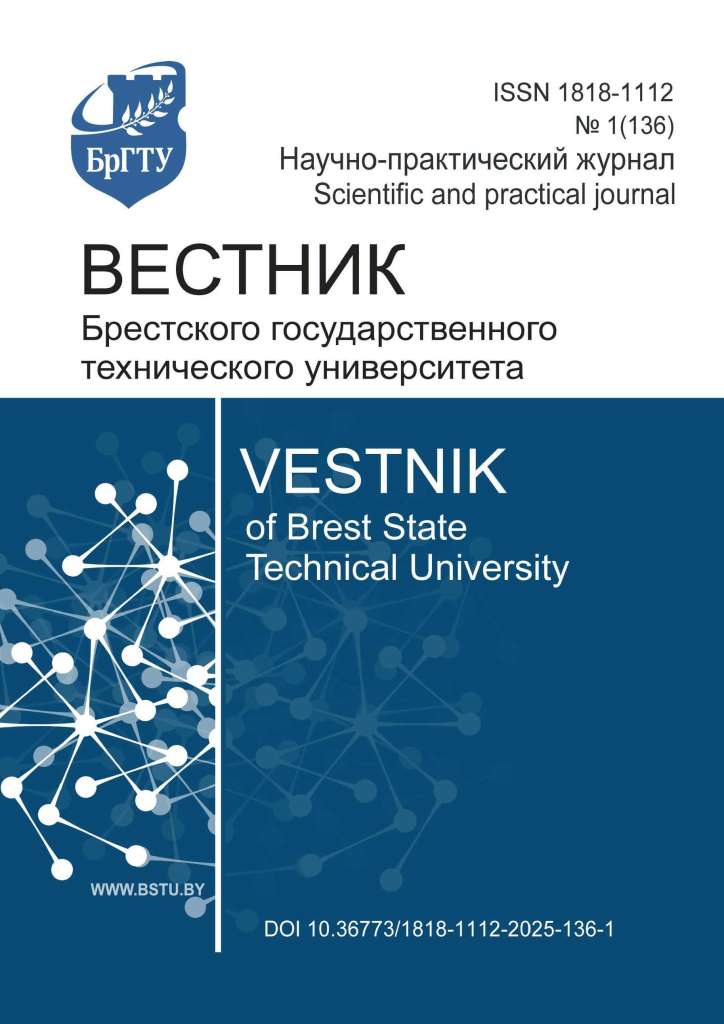SELF-STRAINS AND STIFFNESS CHARACTERISTICS OF SELF-STRESS CONCRETE WITH BASALT FIBER. PARAMETRIC STUDIES
DOI:
https://doi.org/10.36773/1818-1112-2025-136-1-3-7Keywords:
self-stressed concrete, basalt fiber, elastic modulus, self-strainss, Effective Medium TheoryAbstract
The article reflects the results of parametric studies of self-stressed concrete with basalt fiber. The research is based on the consideration of cement composite as a four-component material consisting of aggregate, cement matrix with a transition zone conditionally separated from it, and fiber. In the model the basic provisions of the Effective Medium Theory are applied taking into account the influence of properties of the transition zone. The introduction outlines the relevance of the research. The transit zone is singled out separately as a structural component. Specifics of structure formation and effects accompanying the formation of the transit zone are specified. Approaches to optimize the properties of the transit zone, including through the simultaneous introduction of expanding additives based on high-base metakaolin and disperse reinforcement, are proposed. As a disperse reinforcement basalt fiber as a material compatibilized with cement stone and having increased adhesion characteristics is chosen.
The proposed model makes it possible to reveal the amount of reinforcing component – basalt fiber - required to optimize the structure of self-stressed concrete, which has a non-constant value and varies depending on the change in the stiffness characteristics of both basalt fiber itself and all the components included in the self-stressed concrete. In the model the basic provisions of the theory of effective medium are applied taking into account the influence of the properties of the transit zone.
References
Беломесова, К. Ю. Аналитическая модель расчета количества базальтовой фибры для получения дисперсно-армированного напрягающего бетона оптимальной структуры / К. Ю. Беломесова, И. П. Павлова // Вестник Полоцкого государственного университета. Серия F. Строительство. Прикладные науки. – 2023. – № 1. – С. 27–31. – DOI: 10.52928/2070-1683-2023-33-1-27-31.
Павлова, И. П. Прогнозирование собственных деформаций и напряжений напрягающего бетона на основе структурно-механической модели расширяющегося композита : дис. … канд. техн. наук: 05.23.05 / И. П. Павлова. – Брест, 2005. – 159 л.
Paulava I. Dependence of concrete strength on different methods of basalt fiber addicting / I. Paulava, К. Belamesava // Проблемы современного бетона и железобетона : сб. науч. тр. / Ин-т БелНИИС; редкол.: О. Н. Лешкевич [и др.]. – Минск, 2019. – Вып. 11. – С. 63–75.
Лукутцова, Н. П. Теоретические и технологические аспекты получения микро- и нанодисперсных добавок на основе шунгитосодержащих пород для бетона : монография / Н.П. Лукутцова, А. А. Пыкин. – Брянск : Изд-во БГИТА, 2013. – 231 с.
Кирсанова, А. А. Высокофункциональные тяжелые бетоны, модифицированные модифицированные комплексными добавками, включающими метакаолин: дис. … канд. техн. наук: 05.23.05 / А. А. Кирсанова. – Брест, 2016. – 164 л.
Рекомендации по использованию ВМК производства ООО «СИНЕРГО». – URL: http://metakaolin.ru/Documents/synergo_recommends.pdf (дата обращения: 07.03.2025).
Беломесова, К. Ю. Аналитическая модель расчета количества базальтовой фибры для получения дисперсно-армированного напрягающего бетона оптимальной структуры. параметрические исследования и верификация модели / К. Ю. Беломесова, И. П. Павлова // Вестник Брестского государственного технического университета. – 2024. – № 2 (134). – С. 49–52. – DOI: 10.36773/1818-1112-2024-134-2-49-52.
Рабинович, Ф. Н. Дисперсно-армированные бетоны / Ф. Н. Рабинович. – М. : Стройиздат, 1989. – 176 с.
Розина, В. Е. Мелкозернистый базальтофибробетон с нанокремнеземом : дис. … канд. техн. наук: 05.23.05 / В. Е. Розина. – Улан-Удэ, 2015. – 146 л.
Löfgren, I. In-situ concrete building systems – Developments for industrial construction. Licentiate Thesis. Publication 02:2 / I. Löfgren // Department of Structural Engineering / Chalmers University of Technology. – Feb. 2002. – 138 p.
Тур, В. В. Экспериментально-теоретические основы предварительного напряжения конструкций при применении напрягающего бетона / В. В. Тур. – Брест : БПИ, 1998. – 244 с.
Коротких, Д. Н. Многоуровневое дисперсное армирование структуры мелкозернистого цементного бетона и повышение его трещиностойкости : дис. … канд. техн. наук: 05.23.05 / Д. Н. Коротких. – Воронеж, 2001. – 188 л.
Титов, М. Ю. Бетоны с компенсированной усадкой на расширяющих добавках: автореф. дис. на соискание ученой степени канд. техн. наук : 05.23.05 / М. Ю. Титов; НИИЖБ им. A. A. Гвоздева. – М., 2012. – 22 л.
Потапова, Ю. И. Структура и свойства бетонов с двухстадийным расширением: дис. на соискание ученой степени канд. техн. наук : 05.23.05 / Ю. И. Потапова. – Ростов-на-Дону, 2015. – 254 л.
Павлова, И. П. Зависимость прочности бетона от метода введения базальтовой фибры / И. П. Павлова, К. Ю. Беломесова // Проблемы современного бетона и железобетона : сб. науч. тр. / Ин-т БелНИИС ; редкол.: О. Н. Лешкевич [и др.]. – Минск, 2019. – Вып. 11. – С. 63–75. – DOI: 10.35579/2076-6033-2019-11-05.
Михайлов, В. В. Напрягающий цемент / В. В. Михайлов // Труды совещания по химии цемента. – М. : Промстройиздат, 1956. – 120 с.
Lu, B. Nearest-surface distribution functions for polydispersed particle system / Lu Binglin, S. Torquato // Physical Review A. – 1992. – Vol. 45, Iss. 8. – P. 5530–5544. – DOI: 10.1103/PhysRevA.45.5530.
Garboczi, E. J. Computer Modeling of Interfacial Transition Zone: Microstructure and Properties / E. J. Garboczi, D. P. Bentz // RILEM Report №20, Part 5, Chapter 20. – 1999. – P. 349–385.
Garboczi, E. J. Elastic Moduli of a Material Containing Composite Inclusions: Effective Medium Theory and Finite Element Computations / E. J. Garboczi, J. G. Berryman // Mechanics of Materials. – 2001. – P. 455–470.
Giordano, S. Differential schemes for the elastic characterization of dispersions of randomly oriented ellipsoids / S. Giordano // European Journal of Mechanics - A/Solids. 2023. – Vol. 22, Iss. 6. – P. 885–902. – DOI:10.1016/S0997-7538(03)00091-3.
Downloads
Published
How to Cite
Issue
Section
License

This work is licensed under a Creative Commons Attribution-NonCommercial 4.0 International License.
The work is provided under the terms of Creative Commons public license Attribution-NonCommercial 4.0 International (CC BY-NC 4.0). This license allows an unlimited number of persons to reproduce and share the Licensed Material in all media and formats. Any use of the Licensed Material shall contain an identification of its Creator(s) and must be for non-commercial purposes only. Users may not prevent other individuals from taking any actions allowed by the license.










